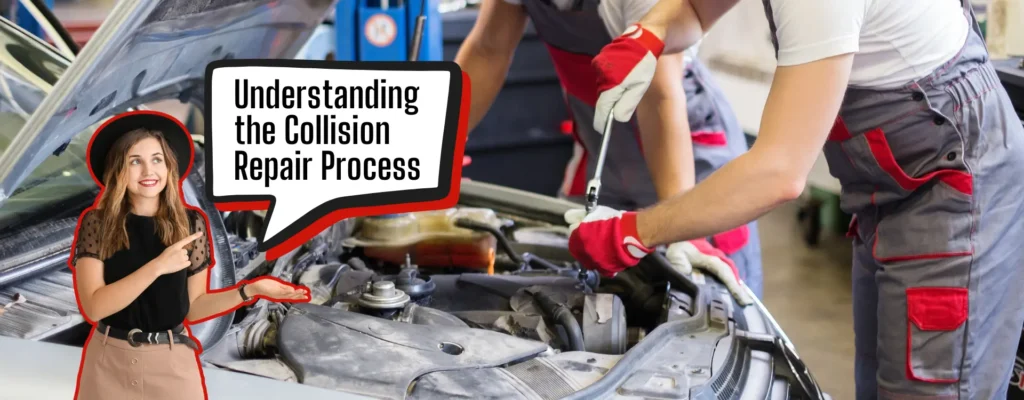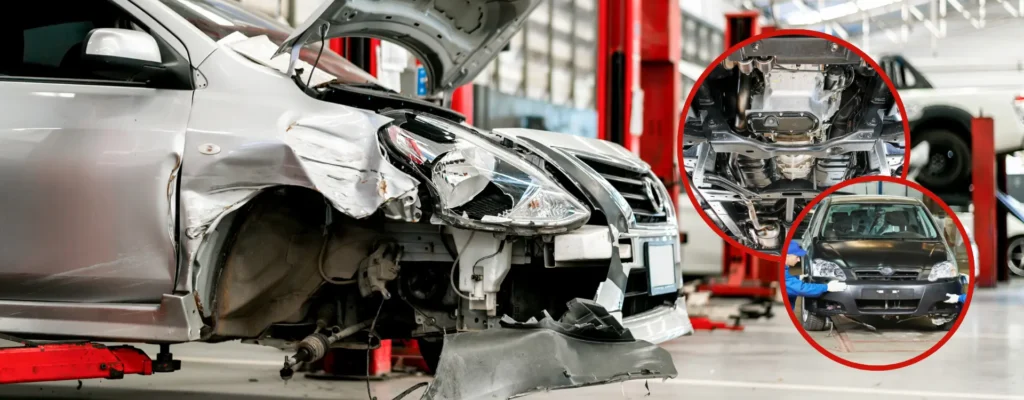- The Auto Body Repair Process
- Disassembly and Damage Analysis: Car Repair Steps
- Structural and Body Repairs
- Paint and Refinishing
- Reassembly and Quality Control
- Collision Repair Process: Final Inspection and Customer Approval
- Who Pays for the Repair Cost?
- Work With the Right Collision Center In Your Area. Find an Auto Body Shop via Collision Connect.

What happens during the process of fixing a car post-accident? This question often arises after a collision, leaving you uncertain about the next steps. Ensuring your vehicle is repaired quickly and correctly becomes crucial.
This article will guide you through the collision repair process, providing clear and practical information to help you make informed decisions about working with the right repair shop and even the costs expected.
IN NEED OF A POST- ACCIDENT CAR REPAIR?
The Auto Body Repair Process
Initial Assessment
It begins with a thorough assessment of your vehicle’s damage. When you bring your car to an auto body shop, technicians will perform a detailed inspection to identify both visible and hidden damage. This step is important to developing an accurate repair plan.
Detailed Repair Estimate
A reputable auto body shop will then provide a detailed estimate. This document outlines the necessary repair cost, including:
- Labor Costs: The cost of the work required to repair your vehicle.
- Parts: A list of parts that need to be replaced or repaired.
- Paint and Materials: Costs associated with repainting and other materials needed for the repair.
- Additional Services: Any extra services, such as alignment or structural repairs.
Disassembly and Damage Analysis: Car Repair Steps
Disassembly
Once you approve the estimate, the next car repair step involves disassembling the vehicle. This allows technicians to uncover any hidden damage that was not apparent during the initial inspection. This step ensures that all necessary repairs are identified and included in the repair plan.
Damage Analysis
During disassembly, the auto body shop will perform a thorough damage analysis. This includes checking the vehicle’s frame, mechanical components, and any internal systems that might have been affected by the collision. The findings will be used to adjust the repair plan if needed, ensuring that all damage is addressed.
Structural and Body Repairs

Structural Repairs
One of the most critical parts of the collision repair process is addressing any structural damage. Technicians will use specialized equipment and measuring systems to realign the vehicle’s frame and unibody structure. This step ensures that your car meets the manufacturer’s specifications for safety and performance.
Body Repairs
Following structural repairs, the focus shifts to the vehicle’s body. This involves fixing dents, scratches, and other exterior damage. Technicians use various techniques to restore the vehicle’s body to its original shape, ensuring a smooth and even surface.
Paint and Refinishing
Car Repair Steps: Paint and Finish
The next car repair step is painting and refinishing. The goal is to match the vehicle’s original color and finish, making the repair seamless and unnoticeable. The process includes:
- Surface Preparation: Sanding and priming the repaired areas to ensure a smooth base for the new paint.
- Color Matching: Using advanced technology to match the vehicle’s original paint color precisely.
- Painting: Applying the paint in a controlled environment to ensure a flawless finish.
- Clear Coating: Adding a protective clear coat to enhance the paint’s durability and shine.
Reassembly and Quality Control
Reassembly
After the paint and refinishing are complete, the vehicle undergoes reassembly. Technicians will reinstall all parts that were removed during disassembly, ensuring they fit correctly and function as intended. This step also includes aligning panels and trim to maintain the vehicle’s appearance.
Quality Control
A crucial part of the repair process is quality control. The shop will perform a detailed inspection to ensure all repairs meet their high standards. This includes checking:
- Alignment and Fit: Ensuring all parts are correctly aligned and fit seamlessly.
- Paint Match: Verifying that the paint matches the original color and finish.
- Functionality: Testing all mechanical and electrical components to ensure they are working properly.
Collision Repair Process: Final Inspection and Customer Approval
Final Inspection
The final car repair step is a comprehensive inspection. The shop will ensure that all repairs have been completed to the highest standard. They will also perform a test drive to check for any remaining issues.
Customer Approval
Before returning your vehicle, the shop will allow you to inspect the repairs and address any concerns. Your satisfaction is crucial, and any reputable shop will ensure you are happy with the work done.
Who Pays for the Repair Cost?
If the accident was found to be your fault, then your insurance provider will cover the cost of repairs minus your deductible. If the other party was at fault, their insurance will cover the repair service bills. In some cases, you may be required to pay for a portion of the auto repairs out-of-pocket.
Work With the Right Collision Center In Your Area. Find an Auto Body Shop via Collision Connect.
Understanding the collision repair process helps you make informed decisions and ensures your vehicle is repaired well. By choosing a trusted auto collision shop, you can confidently restore your vehicle to its pre-accident state.
For those in California looking for reliable auto body shops, Collision Connect offers a network of trusted collision repair shops ready to assist you. Check out Find a Shop to find the right automotive center for your needs.
IN NEED OF A POST- ACCIDENT CAR REPAIR?